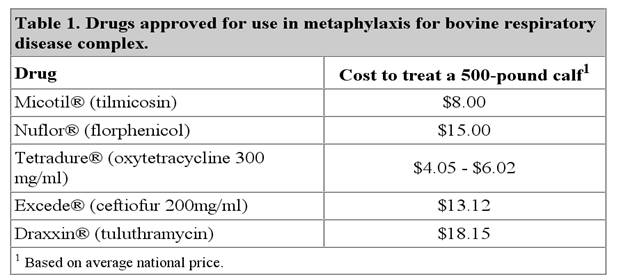You've reached the Virginia Cooperative Extension Newsletter Archive.
These files cover more than ten years of newsletters posted on our old website
(through April/May 2009), and are provided for historical purposes only.
As such, they may contain out-of-date references and broken links.
To see our latest newsletters and current information, visit our website at
http://www.ext.vt.edu/news/.
Newsletter Archive index:
http://sites.ext.vt.edu/newsletter-archive/

Dealing with Respiratory Disease in High-Stress Calves
Livestock Update, September 2008
Dr. W. Dee Whittier,
Extension Veterinarian, Cattle,
VA-MD Regional College of Veterinary Medicine, VA Tech

High stress beef calves result when they are weaned, shipped, exposed to calves from other sources, experience weather and nutritional stress and are handled roughly, especially without prior vaccination and deworming. These calves have a dramatically increased risk of needing to be treated for respiratory disease and dying of the same.
Current conditions suggest that there may be an increased number of high-stress calves in Virginia this fall. For a number of years low corn prices and lots of feedlot capacity have drawn many calves into lots to become “calf feds”. All signals suggest that many less calves will move to feedlots this fall. Far too much expensive corn is required for a 500 pound steer to be finished to make this system economically viable.
At some price, four, five and six weight bawling calves will tempt Virginia cattlemen into a purchase. The chances for a profit on stockering/backgrounding these calves will be dramatically improved if health losses can be minimized. This will take exceptional management in many cases. Some of these calves may spend several days in marketing channels before they finally find a home.
Here are some tips for dealing with disease in high-stress calves:
- Get calves home as soon as possible. Extra hours in a market where calves don’t rest, eat or drink can be very damaging. In addition, calves may be subject to poor ventilation and exposure to many disease agents while they are in marketing channels.
- Consider carefully when to work calves. Most experts recommend working them soon after they arrive at the farm. If calves are left for a few days to settle down, then worked, the stress period is just extended. Early working allows administered vaccines, parasite control, nutritional supplements and antibiotics to go to work. However, a few hours of rest before processing probably don’t make a difference in calf health.
- Deal with bawling/ weaning by finding a compromise between calves walking too far looking for their lost mother and overcrowding them. Look for ways to using walking to have calves find feed and water sources.
- Provide excellent quality feed. Really good hay is a must for most systems. Fall pasture can be excellent once calves are weaned. However, pasturing often makes it hard to observe calves closely and to treat them if they are observed sick. Many hays will need to be supplemented with other feeds to give calves enough energy to stay healthy. By-product feeds such as soy hulls, cottonseed hulls, corn gluten, distillers grains, wheat mids and others have become very popular in weaned calf feeds.
- Don’t overcrowd calves. Once weaning is over, too much confinement stresses calves and concentrates disease organisms. Air quality becomes an issue in many barns as well.
- Carefully consider use of metaphylactic (preventive) antibiotics as calves are worked. The table below gives information about products approved for preventive use. Research has shown a clear economic advantage to using these products with stressed calves. Note that other oxytetracycline products contain the same drug as the approved product and may be quite economical.
- Work with your veterinarian to decide which products to use in your processing program. Most calves will benefit from deworming. Implanting for extra growth will nearly always pay as well. Many options for vaccinations are available. Some veterinarians recommend against the use of modified live IBR and BVD in high-stress calves. Intranasal products may have an advantage in that they are considered quite low stress and provide rapid, local immunity. In some cases vitamin/ mineral injections or probiotics will deal with deficiencies that calves may be experiencing.
- Be prepared to find sick calves. Look for sick calves several times a day. Droopiness and lack of gut fill are very useful signs of sick calves. Finding sick calves early is usually more important to outcome than the antibiotic used to treat them
- Use a thermometer as an aid to verify sick calves and monitor treatment. Expect normal calves to have a temperature of 101.5° F. to 103° F. depending on time of day, outside temperature and amount of activity required to restrain the calf. A 2° F. drop in temperature or a return to normal usually means the treatment is successful.

Proper planning and management of high-stress calves may provide the opportunity for profit in a new beef production climate. Management of these calves requires a high level of management. If either facilities or talented labor is not available, other kinds of cattle may be more appropriate for an operation. Following the above rules will generally provide for manageable levels of disease.

Visit
Virginia Cooperative Extension


![]()
